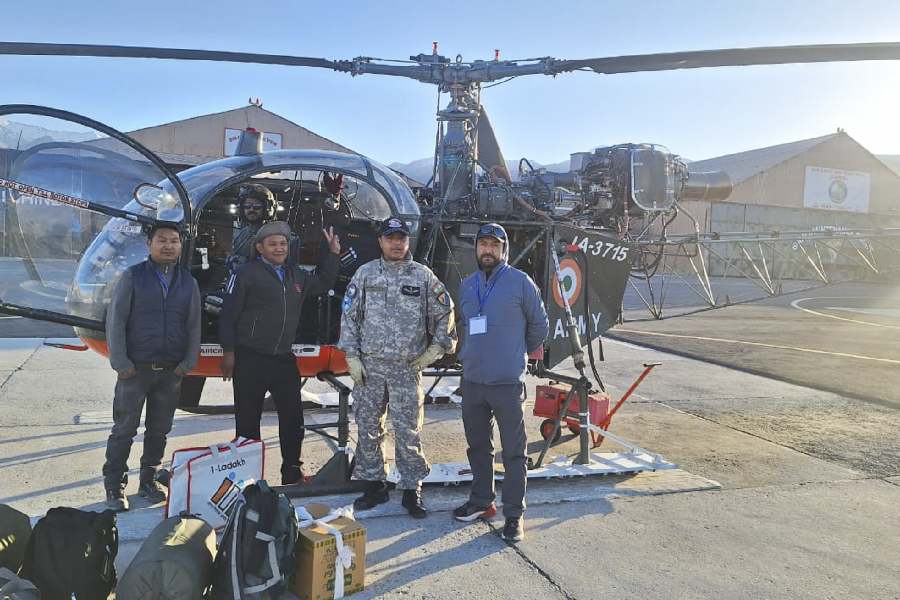Ladakh’s decades-old struggle for empowerment has come unstuck, believes Deldan Namgyal, the former MLA from Leh’s Nubra, even as Buddhists, the main stakeholder of the ongoing fight for survival, are of the view that this Lok Sabha election could further disempower them.
“It looks like a pretty one-sided affair. You have some 88,000-plus voters in Leh and a little over 95,000 voters in Kargil. You have only one candidate from Kargil and two from Leh in the fray. The Leh votes are staring at a split (giving the Kargil candidate an edge),” said Namgyal, who last year quit the Congress to “focus on the struggles needed to safeguard the region”.
Kargil and Leh are two districts of Ladakh. Kargil has a Muslim majority and Leh has more Buddhists. Ladakh overall has a slender Muslim majority with most of them being Shias. In the past, the split in votes between parties backed by two schools of Shia has given the united Buddhists an edge, helping them win the Ladakh parliamentary seat nine out of 13 times.
This election, however, Muslims have rallied behind Haji Mohammad Hanifa Jan of Kargil. Jan was the National Conference (NC) district chief but resigned from the party after party chief Farooq Abdullah asked him to withdraw his candidature in favour of an official Congress nominee. The Kargil Congress strangely is backing him.
The BJP and Congress have fielded T. Namgyal and Tashi Gyalson, both Buddhists, from Leh.
“We have been disempowered (by the abrogation of Article 370 and bifurcation of Jammu and Kashmir state into two Union Territories). There were celebrations here (in Leh) when we got a UT but that euphoria lasted only a year. People then started realising what awaited us,” Deldan Namgyal said.
“Earlier (in J&K state), Ladakh had four MLAs and two MLCs. Now, we have none. We now have only one public representative (an MP). We have two autonomous hill development councils in Leh and Kargil, where the chairmen (literally) had the powers of the chief minister. They enjoyed the protection of Article 370 and 35A but now they are more or less statutory bodies. There are so many bureaucrats who overrule them,” he added.
The top bureaucracy headed by lieutenant governor B.D. Mishra comprises mostly non-locals.
These issues, along with the fear of losing land and jobs to outsiders, have forced the otherwise hostile Buddhist and Muslim communities to unite for statehood and for the Sixth Schedule status, which was met with contempt by the BJP at the Centre.
The Leh Apex Body (LAB), spearheading the fight for special rights in Leh, is said to have separately asked the two candidates to withdraw in favour of others but neither relented, prompting them to adopt a “neutral stance”.
“We have had MPs from Kargil in the past. The MP does not represent Leh or Kargil, they represent the region,” said Chering Dorjay, who heads the Ladakh Buddhist Association, a key constituent of LAB.
“Our struggle is for bigger issues. We are glad the Congress has incorporated our demand for the Sixth Schedule in their national manifesto. We hope that if the Congress comes to power at the Centre, we might get our due. But if the BJP returns, we have no hope for another five years,” Dorjay said.
Many Ladakhi Buddhists today believe their yearning for UT, when they “cozied up” to Hindutva, in the hope of liberating themselves from the “yoke” of Kashmiris, may have been their undoing.
In 2014 and 2019, they rallied behind the BJP, helping it win the seat on both occasions. Many Buddhists, however, fell to the charm of Hindutva much earlier, finding saviours in some of its icons.
Locals say the Hindutva’s journey in the region started with the “chance discovery” of the Indus river by BJP veteran L.K. Advani, during his visit to the place in 1996. When somebody told him that the mighty river flowing in Leh was the mighty Indus, he found the region’s presumed connection with Hindu civilization centred around Indus, also called Sindhu in Sanskrit. The RSS, too, found a toehold in the region.
Till then, Advani’s reported thinking was that the river, along with his homeland Sindh, had gone entirely to Pakistan during partition. The river originates in Tibet and enters Pakistan before passing through Ladakh.
Thus began the celebrated annual Sindhu Darshan festival in 1997. In 2000, then Prime Minister Atal Bihari Vajpayee inaugurated a grand pavilion at Shey, 15km from Leh, on the banks of the river.
“Some people asked about the existence of Sindhu in India as described in our national anthem but little did they know that it flows from our soil in Ladakh,” he had famously said. Every year, India’s top dignitaries participate in the festival, organised by Sindhu Darshan Yatra Samiti. Since then, the place has witnessed an infrastructure boom.
Though initially welcomed by a few sections of Buddhists, the festival is now a source of extreme anxiety for locals.
“We never came across the name Sindhu before. Our name for the river is Singhey Khabab. They are building a lot of festival-related infrastructure here. It is said that when Vajpayee asked Farooq Abdullah (chief minister in 2000) to allot land for the project, he told him he could have as much land as far as his eyes could see. Soon after the PM left, Farooq told his local officers not to give an inch,” said Deldan Namgyal.
Ladakh votes on May 20










